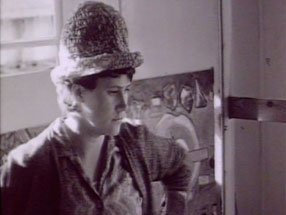Osieki 1965
3rd Osieki Plein-air. International Meeting of Artists and Theoreticians of Art
The Organisation Committee of the 3rd Plein-air, in their efforst to satisfy the great expectations aroused by the success of the previous meetings in Osieki, has made an attempt to combine the “international” character with the scientific profile of Osieki. For the first time, the graphic sign of the meeting, designed by Jerzy Fedorowicz, appeared in the folder Informator, published in three languages.
The opinion of Henryk Stażewski, who regarded the Koszalin Plein-air as “a sort of congress devoted to arts”, was approached seriously by the organisers, who invited theoreticians of art to the meeting.
The 3rd Plein-air in Osieki lasted from the 28th August to the 15th September 1965. It gathered 30 artists, including Henryk Stażewski and Maria Ewa Łunkiewicz as guests of honour.
Seven critics and theoreticians of art dealt with the problems of art and artistic critique in their lectures: Jerzy Ludwiński "A Few Paradoxes of Contemporary Art", Mariusz Tchorek "Aesthetics and Creativity", Hanna Ptaszkowska "The Problem of Modern Poetry", Julian Przyboś "About Modern Poetry". Janusz Bogucki held a lecture entitled, "The Current Output in Fine Arts in Poland" and guided numerous school and factory trips visiting the Osieki Plein-air.
Apart from didactic exhibitions delivered by Janusz Bogucki and Maria Bogucka, individual exhibitions by the following artists were presented: Maria Antoszkiewicz, Ireneusz Pierzgalski and Stanisław Fijałkowski, Jan Chwałczyk and Wanda Gołkowska, as well as after-plein-air exhibition. A retrospective exhibition of the Osieki gifts was presented in the Musuem of Middle Pomerania in Słupsk. The artist took part in meetings with pupils of high schools, teachers and individual tourists.
After the plein-air press discussion was triggered focused on the future of "Koszalin initiative". Some posed directly the question, "Is This the Dusk of the Koszalin Plein-air?". Doubts regarding the increasing plein-air movement, contributing to "the depravation of the value and significance of the event in the view of the society, and promotes the vulgarisation of the meeting idea", and the idea of "a totally new concept of the Koszalin event proposed by two, three groups" were expressed for the first time in the "Report of the Organisation Committee of The Koszalin Plein-air in Osieki".
The need to summarise the output of the first three plein-airs resulted in the publishing of the "Koszalin Plein-airs" book by the Social and Cultural Association of Koszalin.
Requested to comment on the so-far output of the meetings, Hanna Ptaszkowska put it in the following words:
'The meaning of the Koszalin Plein-air can be considered from different perspectives. One of them is the idea of plein-air as beginning of the countrywide artistic environment. This encounter of over 30 painters, critics and scientists created the grounds for unrestricted contact. (…) It is a fact that the atmosphere at the Osieki Plein-air made for free manifestation of any forms of artistic activity. Therefore, the artistic effects of plein-air are very interesting and they have adopted a great variety of forms. These can be grouped into three categories. First of all, the plein-air output in the form of paintings painted in their course, which can form the basis of the Koszalin gallery.(...) Another achievement of the plein-air are the theoretical concepts and considerations which emerged during the plein-air meetings and discussions and its artistic output. It is very specific to the atmosphere of the plein-air that all the theoretic concepts outlined in these meetings concerned the most topical artistic issues, that the statements of the artists and critics were a demonstration of an active attitude towards the problems of contemporary art. These meetings did not have thus a charakter of academic seminars. The atmosphere which was created around them is related to the third achievement of the Plein-air. It can be verbalised as late as today, as it pertains to some changes in the artistic life of Poland, which occurred after the conclusion of the plein-air and with no doubt under its influence. This shift is a tightening of contacts between the artists and critics from various environments of Poland. This following up of contacts established on the plein-air bore fruits in the form of exhibitions exchanged between Warsaw, Wrocław and Łódź, in from of meeting together with an exhibitionof all the plein-air participants at the Gallery of Modern Art in Warsaw, and finally, in the form of never-ending meetings and private or organised debates.'
(Excerpt from: Ewa Kowalska, The Calendarium of the Osieki Plein-airs 1963-1981, [in:] Avant-garde in Plein-air: Osieki and Łazy 1963-1981, ed. Ryszard Ziarkiewicz, Museum of Koszalin 2008)
Year: 1965
Duration: 8'35"
Language: no sound
Source: 16 mm
© Museum of Koszalin
Acquisition: deposit
Ownership form: deposit


